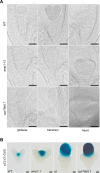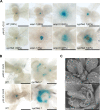AMP1 and CYP78A5/7 act through a common pathway to govern cell fate maintenance in Arabidopsis thaliana
- PMID: 32960882
- PMCID: PMC7531801
- DOI: 10.1371/journal.pgen.1009043
AMP1 and CYP78A5/7 act through a common pathway to govern cell fate maintenance in Arabidopsis thaliana
Abstract
Higher plants can continuously form new organs by the sustained activity of pluripotent stem cells. These stem cells are embedded in meristems, where they produce descendants, which undergo cell proliferation and differentiation programs in a spatiotemporally-controlled manner. Under certain conditions, pluripotency can be reestablished in descending cells and this reversion in cell fate appears to be actively suppressed by the existing stem cell pool. Mutation of the putative carboxypeptidase ALTERED MERISTEM PROGRAM1 (AMP1) in Arabidopsis causes defects in the suppression of pluripotency in cells normally programmed for differentiation, giving rise to unique hypertrophic phenotypes during embryogenesis as well as in the shoot apical meristem. A role of AMP1 in the miRNA-dependent control of translation has recently been established, however, how this activity is connected to its developmental functions is not resolved. Here we identify members of the cytochrome P450 clade CYP78A to act in parallel with AMP1 to control cell fate in Arabidopsis. Mutation of CYP78A5 and its close homolog CYP78A7 in a cyp78a5,7 double mutant caused suspensor-to-embryo conversion and ectopic stem cell pool formation in the shoot meristem, phenotypes characteristic for amp1. The tissues affected in the mutants showed pronounced expression levels of AMP1 and CYP78A5 in wild type. A comparison of mutant transcriptomic responses revealed an intriguing degree of overlap and highlighted alterations in protein lipidation processes. Moreover, we also found elevated protein levels of selected miRNA targets in cyp78a5,7. Based on comprehensive genetic interaction studies we propose a model in which both enzyme classes act on a common downstream process to sustain cell fate decisions in the early embryo and the shoot apical meristem.
Conflict of interest statement
The authors have declared that no competing interests exist.
Figures










References
-
- Pilkington M. The Regeneration of the Stem Apex. New Phytologist. 1929;28(1):37–53.
-
- Loiseau JE. Observations et experimentation sur la phyllotaxie et le fonctionnement du sommet vegetatif chez quelques Balsaminacees. Ann Sci Nat Bot Ser. 1959;11:201–14.
Publication types
MeSH terms
Substances
LinkOut - more resources
Full Text Sources
Molecular Biology Databases

